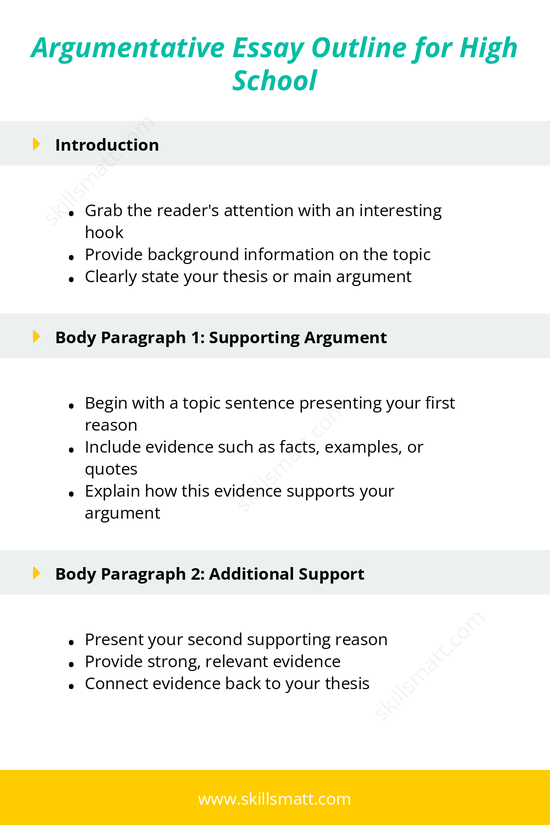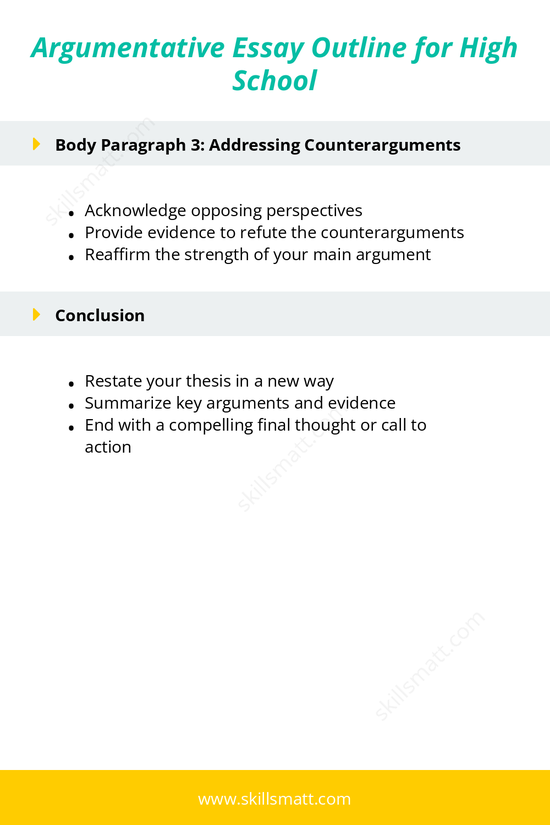Writing an argumentative essay is a skill that every high school student should master. Whether you are defending a point of view or discussing an issue, the ability to present a well-organized argument is key to success. Below is a detailed argumentative essay outline that will guide high school students in crafting a compelling essay that grabs attention, presents solid evidence, and effectively addresses counterarguments.
Introduction
The introduction is your first opportunity to engage the reader and set the tone for your entire essay. It should capture the reader's attention and clearly present your main argument or thesis.
- Grab the reader’s attention: Start with a hook that sparks interest. This could be a provocative question, an interesting fact, or a relevant quote. The hook will entice the reader to keep reading.
- Provide background information: After the hook, offer some context for the issue at hand. This will help the reader understand the importance of the topic and why it matters.
- Clearly state your thesis: The thesis statement should succinctly express your main argument. It will be the guiding force for the rest of your essay, so make sure it’s clear and concise.
Body Paragraph 1: Supporting Argument
The first body paragraph should present your strongest supporting argument for your thesis. Make sure to structure the paragraph logically, and use evidence that is both relevant and compelling.
- Begin with a topic sentence: Start with a clear topic sentence that introduces your first supporting reason. This sets the tone for the paragraph and helps the reader understand the point you’re making.
- Include evidence: Provide evidence such as facts, examples, or quotes from credible sources. The evidence should directly support your reason and help persuade the reader of your point of view.
- Explain the evidence: Don’t just present evidence—analyze it. Explain how the evidence supports your argument and why it is significant to the issue you are addressing.
Body Paragraph 2: Additional Support
The second body paragraph should introduce another supporting argument. This helps to reinforce your thesis and provide a deeper understanding of your position.
- Present your second supporting reason: Just like the first body paragraph, begin with a topic sentence that introduces a new reason for your argument. This adds depth and breadth to your essay.
- Provide strong, relevant evidence: Use more evidence that supports your second reason. This could be in the form of data, expert opinions, or personal anecdotes.
- Connect evidence back to your thesis: It’s important to link your supporting evidence to your main argument. Show how this new point strengthens your thesis and helps move your argument forward.
Body Paragraph 3: Addressing Counterarguments
In this section, you should acknowledge the opposing viewpoints and address them in a respectful manner. This demonstrates that you’ve considered alternative perspectives and that your argument is still the strongest one.
- Acknowledge opposing perspectives: Briefly explain the opposing viewpoint to show that you understand the issue from different angles. This can help establish your credibility as a writer.
- Provide evidence to refute the counterarguments: After acknowledging the counterargument, you need to provide evidence that disproves or weakens the opposing viewpoint. This could include data, expert opinions, or logical reasoning.
- Reaffirm the strength of your argument: After addressing counterarguments, reassert the strength of your main argument. Show why your position is more compelling and based on stronger evidence.
Conclusion
The conclusion is where you wrap up your argument and leave the reader with a lasting impression. It should briefly summarize the main points, reaffirm your thesis, and leave the reader with something to think about.
- Restate your thesis: In the conclusion, restate your thesis in a new way. This helps reinforce your main argument and reminds the reader of your position.
- Summarize key arguments and evidence: Briefly summarize the most important points you made in the body paragraphs. This reinforces your argument and makes your essay feel cohesive.
- End with a compelling final thought or call to action: The conclusion should leave the reader with something to think about. This could be a call to action, a reflection on the broader implications of the topic, or a thought-provoking question that encourages further reflection.
In conclusion, writing an argumentative essay is about presenting a well-supported argument, addressing opposing viewpoints, and convincing the reader of your perspective. By following this outline and using solid evidence, you’ll be able to craft an effective argumentative essay that not only persuades but also engages the reader.


